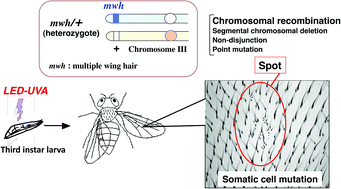Somatic cell mutations caused by 365 nm LED-UVA due to DNA double-strand breaks through oxidative damage
Abstract
Evidence is accumulating indicating that UVA (320–400 nm ultraviolet light) plays an important role in photo-carcinogenesis. UVA is thought to produce reactive oxygen species in irradiated cells through photo-activation of inherent photosensitizers, and was recently reported to cause DNA double-strand breaks (DSBs) in exposed cells. We have investigated the involvement of UVA in mutations and DNA damage in somatic cells using Drosophila melanogaster larvae. Using the Okazaki Large Spectrograph, we previously observed that longer wavelength UVA (>330 nm) was more mutagenic in post-replication repair-deficient D. melanogaster (mei-41) than in the nucleotide excision repair-deficient strain (mei-9). LED-light has recently been developed as a high-dose-rate UVA source. LED-UVA light (365 nm) was also more mutagenic in mei-41 than in mei-9. The mei-41 gene was shown to be an orthologue of the human ATR gene, which is involved in the repair of DSBs through phosphorylation of histone H2AX. In order to estimate the extent to which oxidative damage contributes to mutation, we established a new D. melanogaster strain (urate-null mutant) that is sensitive to oxidative damage and has a marker to detect somatic cell mutations. When somatic cell mutations were examined using this strain, LED-UVA was mutagenic in the urate-null strain at doses that were non-mutagenic in the urate-positive strain. In an effort to investigate the generation of DSBs, we examined the presence of phosphorylated histone H2AvD (H2AX D. melanogaster homologue). At high doses of LED-UVA (>800 kJ m−2), levels of phosphorylated H2AvD (γ-H2AvD) increased significantly in the urate-null strain. Moreover, the level of γ-H2AvD increased in the excision repair-deficient strain but not in the ATR-deficient strain following UVA-irradiation. These results supported the notion that the generation of γ-H2AvD was mediated by the function of the mei-41 gene. It was reported that ATR functions on DSB repair in D. melanogaster. Taken together, we propose a possible pathway for UVA-induced mutation, whereby DNA double-strand breaks resulting from oxidative stress might be responsible for UVA-induced mutation in somatic cells of D. melanogaster larvae.


 Please wait while we load your content...
Please wait while we load your content...